六年级英语知识点整理
六年级英文知识点归纳总结
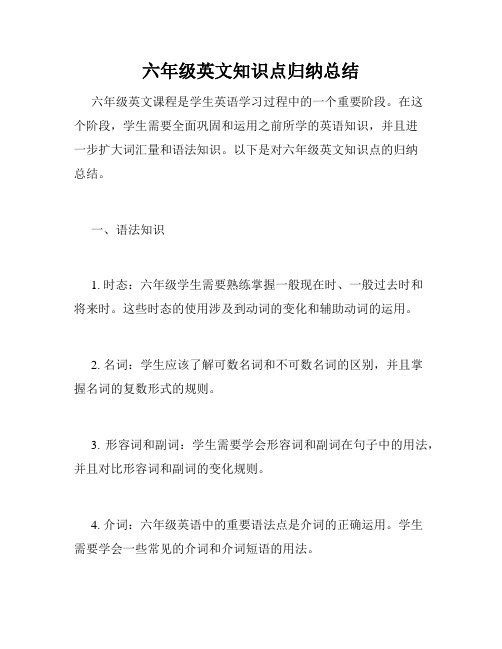
六年级英文知识点归纳总结六年级英文课程是学生英语学习过程中的一个重要阶段。
在这个阶段,学生需要全面巩固和运用之前所学的英语知识,并且进一步扩大词汇量和语法知识。
以下是对六年级英文知识点的归纳总结。
一、语法知识1. 时态:六年级学生需要熟练掌握一般现在时、一般过去时和将来时。
这些时态的使用涉及到动词的变化和辅助动词的运用。
2. 名词:学生应该了解可数名词和不可数名词的区别,并且掌握名词的复数形式的规则。
3. 形容词和副词:学生需要学会形容词和副词在句子中的用法,并且对比形容词和副词的变化规则。
4. 介词:六年级英语中的重要语法点是介词的正确运用。
学生需要学会一些常见的介词和介词短语的用法。
5. 句型:学生需要学习并熟练掌握各种常用句型,包括肯定句、否定句、疑问句等。
二、词汇六年级的英语课程会进一步扩大学生的词汇量,并且注重词汇的灵活运用。
以下是一些六年级常见的词汇知识点:1. 数字和计量单位:学生需要掌握数字0-1000,并且了解一些常见的计量单位,比如长度、重量、时间等。
2. 时间词:学生应该熟悉一天的时间段、星期几、月份和季节等。
3. 家庭成员和亲属:学生需要学习家庭成员(比如父母、兄弟姐妹)和亲属关系的英文表达。
4. 动物和植物:学生需要掌握一些常见的动物和植物的英文名称,并且了解它们的特征和生活习性。
5. 学科和学习用品:学生需要学习各种学科的英文表达,比如数学、科学、语文等,并且了解一些常见的学习用品的英文名称。
三、阅读理解阅读理解是英语学习中的重要部分,六年级的学生需要通过阅读文章进行理解并回答问题。
以下是提高阅读理解能力的几个要点:1. 阅读技巧:学生需要掌握一些阅读技巧,比如快速浏览、扫读、细读和推断等。
2. 理解词汇:学生需要通过上下文来理解生词的含义,而不是依赖字典。
3. 抓住关键信息:学生需要学会从文章中抓住关键信息,并且能够通过问题回答的方式来进行思考和分析。
4. 理解文章结构:学生需要理解文章的结构,包括开头、主体和结尾,以及段落之间的逻辑关系。
六年级基本英语知识点总结
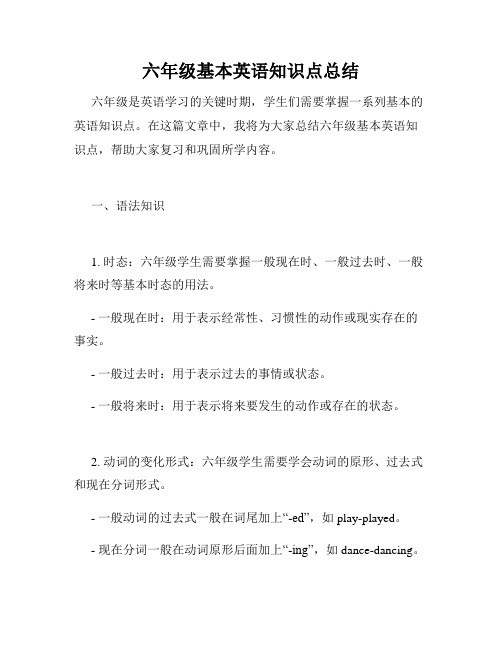
六年级基本英语知识点总结六年级是英语学习的关键时期,学生们需要掌握一系列基本的英语知识点。
在这篇文章中,我将为大家总结六年级基本英语知识点,帮助大家复习和巩固所学内容。
一、语法知识1. 时态:六年级学生需要掌握一般现在时、一般过去时、一般将来时等基本时态的用法。
- 一般现在时:用于表示经常性、习惯性的动作或现实存在的事实。
- 一般过去时:用于表示过去的事情或状态。
- 一般将来时:用于表示将来要发生的动作或存在的状态。
2. 动词的变化形式:六年级学生需要学会动词的原形、过去式和现在分词形式。
- 一般动词的过去式一般在词尾加上“-ed”,如play-played。
- 现在分词一般在动词原形后面加上“-ing”,如dance-dancing。
3. 名词的单复数形式:六年级学生需要掌握名词单数和复数形式的变化规则。
- 一般情况下,在名词词尾加上“-s”表示复数形式,如book-books。
- 以“s”、“x”、“ch”、“sh”和“o”结尾的名词,复数形式一般在词尾加上“-es”,如box-boxes。
二、词汇知识1. 常见动词:六年级学生需要积累常见的动词词汇,如eat、drink、read、write等。
2. 常见名词:六年级学生需要掌握一些常见的名词,如book、pen、school、teacher等。
三、句型知识1. 简单句:六年级学生需要学会构建简单句,包括主语、谓语、宾语的搭配和语序等。
- 主语:句子中执行动作或者是状态的人或事物。
- 谓语:表示主语动作、情感或状态的动词。
- 宾语:动作的承受者或指向的人或事物。
2. 疑问句:六年级学生需要学会构建疑问句,包括疑问词的使用和语序的变化等。
- 疑问词:用于引导疑问句的词语,如what、when、where、why等。
- 语序:疑问句的语序一般将谓语动词提前于主语。
四、阅读技巧1. 阅读理解:六年级学生需要通过大量的阅读,掌握阅读理解的技巧。
- 理解词义:通过上下文推断单词的意思。
小学六年级英语知识点大全

小学六年级英语知识点大全一、单词拼写(Spelling)1. 家庭成员(Family members)- father 父亲- mother 母亲- brother 兄弟- sister 姐妹- grandmother 奶奶- grandfather 爷爷- uncle 叔叔- aunt 阿姨2. 动物(Animals)- cat 猫- dog 狗- rabbit 兔子- bird 鸟- fish 鱼- cow 牛- horse 马- elephant 大象3. 食物(Food)- apple 苹果- banana 香蕉- orange 橙子- bread 面包- rice 米饭- milk 牛奶- egg 鸡蛋- cake 蛋糕4. 学校用品(School supplies)- notebook 笔记本- pencil 铅笔- pen 钢笔- ruler 尺子- eraser 橡皮擦- backpack 背包- scissors 剪刀- glue 胶水5. 季节(Seasons)- spring 春天- summer 夏天- autumn 秋天- winter 冬天二、语法(Grammar)1. 名词(Nouns)名词是用来表示人、动物、物品或抽象概念的词语。
例句:- This is a book.(这是一本书。
)- I have a cat.(我有一只猫。
)- My favorite color is blue.(我最喜欢的颜色是蓝色。
)2. 形容词(Adjectives)形容词用来描述名词的特征或状态。
例句:- The sky is blue.(天空是蓝色的。
)- She is a beautiful girl.(她是一个美丽的女孩。
)- This is a big house.(这是一座大房子。
)3. 代词(Pronouns)代词用来替代名词,以避免重复使用。
例句:- He is my friend.(他是我的朋友。
六年级英语全部知识点

六年级英语全部知识点一、基础语法知识1. 词性及词类转换:名词、动词、形容词、副词、代词、介词、冠词等。
2. 句子成分:主语、谓语、宾语、定语、状语等。
3. 时态和语态:一般现在时、一般过去时、一般将来时、被动语态等。
4. 比较级和最高级:形容词和副词的比较级和最高级形式及用法。
5. 直接引语和间接引语:使用和转换直接引语和间接引语。
6. 疑问句和否定句:构成和变换疑问句和否定句。
7. 句型转换:选择适当的句型进行句子转换。
二、词汇与短语1. 常用单词:认读和拼写常见单词,包括名词、动词、形容词、副词等。
2. 词组和短语:学习常用的固定搭配和日常用语表达。
3. 同义词和反义词:学习常见词语的同义词和反义词。
三、阅读理解1. 短文理解:阅读短文,回答问题或完成相关任务。
2. 阅读策略:使用不同的阅读策略,如预测、推理、细节获取等。
3. 阅读技巧:学习如何快速定位信息,并理解文章的主旨和要点。
四、写作技巧1. 句子构造:运用所学的语法知识构造完整的句子。
2. 选择恰当的词汇:根据语境选择合适的词汇。
3. 写作规范:注意句子结构和标点符号的使用。
4. 表达观点:用简洁明了的语言表达自己的观点和意见。
五、口语表达1. 日常用语:学习基本的问候和日常用语表达。
2. 对话交流:练习进行简单的对话和交流。
3. 角色扮演:模拟真实场景,进行角色扮演对话。
六、听力技巧1. 听懂关键信息:提高听力理解能力,抓住关键信息。
2. 根据所听内容回答问题:通过听力材料回答问题或完成相关任务。
3. 跟读练习:提高发音和语调,跟读所听内容。
七、语法综合运用1. 完形填空:根据上下文语境,选择合适的词汇填空。
2. 语法填空:根据所给的语法规则和句子结构,填写正确的词语。
3. 句型转换:根据提示,将句子进行结构转换。
4. 语法错误改正:找出句子中的语法错误,并进行修改。
八、语言知识运用1. 单句翻译:将中文句子翻译成英文,或将英文句子翻译成中文。
六年级英语必背知识点 ( 大全 )
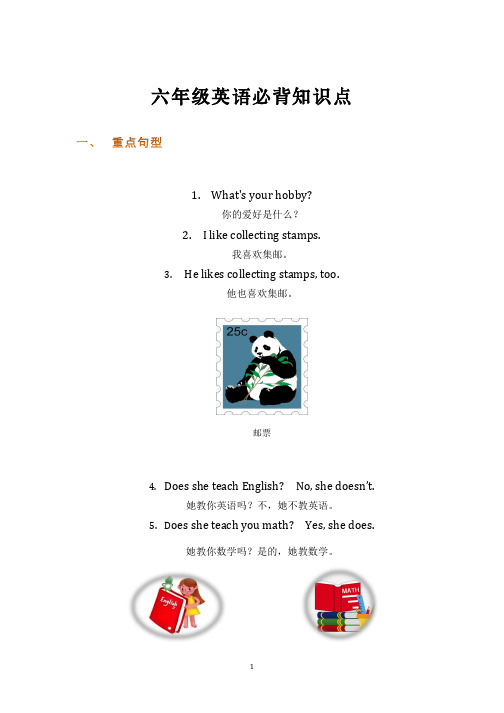
5. Does she teach you math? Yes, she does.
她教你数学吗?是的,她教数学。
1
动词变为动名词,即动词加 “ing”。一般要遵循以下三条规则。
1) 一般情况下,在动词后面直接加 “ing”。 举例: play - playing read - reading do – doing go – going
1) I like swimming. 我喜欢游泳 (表达自己喜欢的爱好第一种说法)
2
2) Swimming is my hobby. 游泳是我的爱好。(表达自己喜欢的爱好第二种说法) 3) My hobby is swimming. 我的爱好是游泳。(表达自己喜欢的爱好第三种说法)
动词变为第三人称单数形式的规则:
2) 以不发音的字母 “ e “ 结尾的动词,要去掉不发音“ e “ ,再加 “ing”。 举例: write - writing ride - riding make - making dance – dancing
3) 以单元音加单辅音结尾的重读闭音节,要双写最后一个辅音字母,再加“ing”。 举例: run –running swim - swimming put - putting sit – sitting
1) 在一个句子中,如果主语人称既不是“你”,也不是“我”,而是“另外的一个 人”,这时的人称叫做“第三人称单数”。
2) 在“第三人称”单词的句子中,动词要使用“第三人称”单词形式。 3) 动词变为第三人称单数形式,要遵循以下规则: 1. 一般情况下,在动词的后面直接加 “s”。
例如: read - reads make – makes write – writes
六年级英语必考知识点公式

六年级英语必考知识点公式一、英语时态1. 一般现在时:主语 + 动词原形(第三人称单数在动词原形后加-s)例句:Tom likes playing basketball.2. 一般过去时:主语 + 动词过去式(动词过去式根据规则变化)例句:Sarah watched a movie last night.3. 现在进行时:主语 + be (am/is/are) + 动词-ing例句:They are studying for the exam.4. 过去进行时: 主语 + was/were + 动词-ing例句:She was reading a book when I saw her.5. 过去将来时: 主语 + would + 动词原形例句:He said he would come to the party.6. 现在完成时: 主语 + have/has + 动词过去分词例句:I have finished my homework.二、疑问句及否定句1. 疑问句: 助动词/Be动词/情态动词 + 主语 + 动词原形例句:Do you like ice cream? Is he coming?2. 否定句: 主语 + do/does/did not + 动词原形例句:She does not play tennis. They did not go to the park.三、单复数形式1. 名词的复数形式: 大部分名词 + s/es例句:Apples, books, boxes2. 动词的第三人称单数形式: 动词原形 + s例句:He likes to play soccer. She sings beautifully.四、情态动词的用法1. can: 表示能力、允许例句:I can swim. Can I borrow your pen?2. must: 表示必须例句:You must finish your homework.3. should: 表示建议、应该例句:We should study hard for the exam.五、比较级和最高级1. 比较级:形容词/副词 + er例句:She is taller than me.2. 最高级:形容词/副词 + est例句:He is the tallest boy in our class.六、介词1. in:表示在某个位置或某段时间内例句:I live in a big house. We will have a meeting in the afternoon.2. on:表示在某个表面或某个特定的日期例句:Put the book on the table. My birthday is on October 10th.七、连词1. and:表示并列关系例句:I like apples and oranges.2. but:表示转折关系例句:She is tired but happy.八、日常表达1. 问候语: Hello! Hi! Good morning! Good afternoon! Good evening! How are you?例句:Hello! How are you today?2. 道别语: Goodbye! Bye! See you later! See you tomorrow!例句:Goodbye! See you tomorrow!以上是六年级英语必考知识点的公式总结。
六年级英语必考知识点归纳
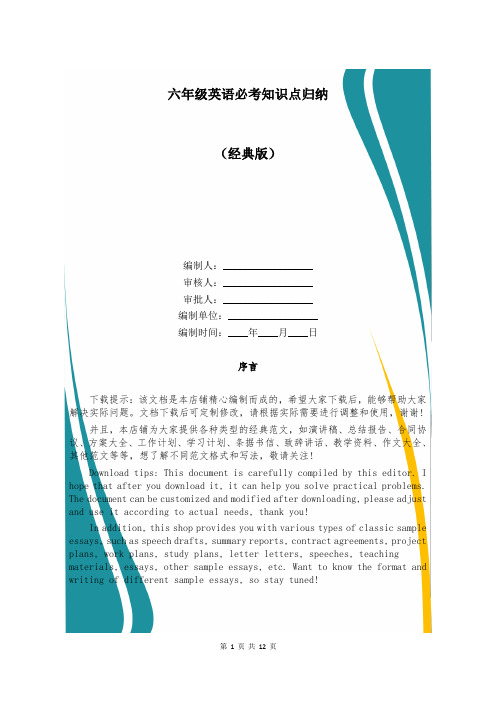
六年级英语必考知识点归纳(经典版)编制人:__________________审核人:__________________审批人:__________________编制单位:__________________编制时间:____年____月____日序言下载提示:该文档是本店铺精心编制而成的,希望大家下载后,能够帮助大家解决实际问题。
文档下载后可定制修改,请根据实际需要进行调整和使用,谢谢!并且,本店铺为大家提供各种类型的经典范文,如演讲稿、总结报告、合同协议、方案大全、工作计划、学习计划、条据书信、致辞讲话、教学资料、作文大全、其他范文等等,想了解不同范文格式和写法,敬请关注!Download tips: This document is carefully compiled by this editor. I hope that after you download it, it can help you solve practical problems. The document can be customized and modified after downloading, please adjust and use it according to actual needs, thank you!In addition, this shop provides you with various types of classic sample essays, such as speech drafts, summary reports, contract agreements, project plans, work plans, study plans, letter letters, speeches, teaching materials, essays, other sample essays, etc. Want to know the format and writing of different sample essays, so stay tuned!六年级英语必考知识点归纳学会整合知识点。
完整版)六年级英语语法知识点汇总
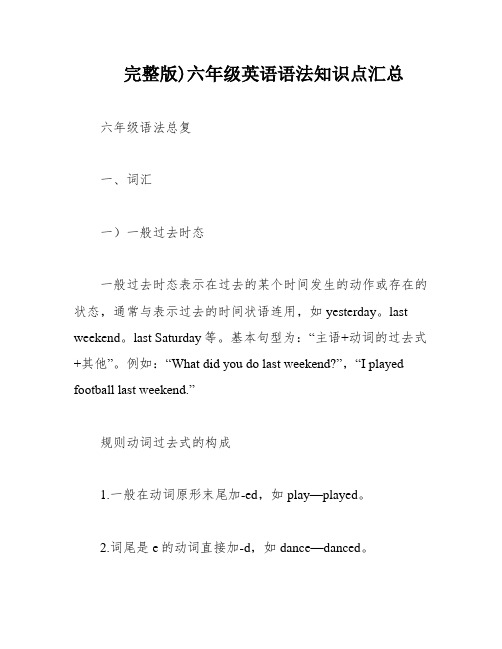
完整版)六年级英语语法知识点汇总六年级语法总复一、词汇一)一般过去时态一般过去时态表示在过去的某个时间发生的动作或存在的状态,通常与表示过去的时间状语连用,如yesterday。
last weekend。
last Saturday等。
基本句型为:“主语+动词的过去式+其他”。
例如:“What did you do last weekend?”,“I played football last weekend.”规则动词过去式的构成1.一般在动词原形末尾加-ed,如play—played。
2.词尾是e的动词直接加-d,如dance—danced。
3.末尾只有一个辅音字母的重读闭音节词,先双写这个辅音字母,再加-ed,(停止)ped。
4.结尾是“辅音字母+y”的动词,变“y”为“i”,再加-ed,如study--studied。
一些不规则变化的动词过去式am/is—was,are—were,see—saw,take—took,read—read,sleep(睡觉)—slept,go—went,come—came,swim—swam,fly—flew,e—became,do—did,get—got,have—had,draw—drew,say—said,hurt—hurt,win—won,tell—told,will—would,eat—ate,cut(切)--cut,sit(坐)—sat,think—thought,find—found,make—made,drink—drank,run(跑)—ran,wear—wore,begin(开始)—began,buy—bought,give(给)—gave,sing—sang。
二)一般现在时态一般现在时态表示包括现在时间在内的一段时间内经常发生的动作或存在的状态,表示惯性或客观存在的事实和真理,通常与often。
always。
usually。
sometimes。
英语所有语法知识点六年级

英语所有语法知识点六年级一、动词时态1. 一般现在时:用于表示经常性或普遍性的动作、情况或状态例句:I play football every Sunday.2. 一般过去时:用于表示过去某个时间发生的动作或状态例句:She watched a movie yesterday.3. 一般将来时:用于表示将来要发生的动作或情况例句:I will visit my grandparents next week.4. 进行时态:用于表示正在进行的动作例句:They are eating lunch now.5. 完成时态:用于表示已经完成的动作或状态例句:He has finished his homework.二、名词1. 可数名词与不可数名词例句:There are three apples on the table. (可数名词) I want some water. (不可数名词)2. 单数名词与复数名词例句:The dog is cute. (单数名词)The dogs are playing in the park. (复数名词)3. 名词所有格例句:Tom's book is on the table.三、形容词与副词1. 形容词用于修饰名词,表示名词的性质、特征或状态例句:She has a beautiful flower.2. 副词用于修饰动词、形容词或副词,表示方式、程度或时间等例句:He runs quickly.四、冠词1. 不定冠词(a/an)用于泛指单数可数名词前例句:I see an apple.2. 定冠词(the)用于特指或泛指某个人或物例句:The cat is on the table.五、代词1. 主格代词用于作主语例句:She is my friend.2. 宾格代词用于作宾语例句:He gave me a present.3. 物主代词表示所属关系例句:This is his book.六、介词1. 介词用于表示位置、时间、原因、方式等例句:He is in the park.2. 一些常见介词:in, on, at, with, for, to 等七、连词1. 并列连词用于连接同等重要的词、短语、句子等例句:I like apples and oranges.2. 从属连词用于引导从句例句:She is happy because she won the game.八、疑问词1. 疑问词用于构成疑问句例句:Where is the book?九、形容词比较级与最高级1. 形容词比较级用于表示两者之间的比较例句:She is taller than her sister.2. 形容词最高级用于表示三者或三者以上的比较例句:She is the tallest girl in the class.十、情态动词1. 情态动词用于表示能力、可能性、许可等例句:I can swim.十一、直接引语与间接引语1. 直接引语直接引述别人的原话例句:He said, "I am happy."2. 间接引语是对别人的话进行转述例句:He said he was happy.以上是六年级英语的所有语法知识点,掌握这些知识将会帮助你更好地理解和运用英语语法。
小学六年级英语最全知识点

小学六年级英语最全知识点一、词汇知识1. 单词拼写:熟练掌握课本中的单词拼写,如人称代词、动词过去式、形容词、副词等。
2. 同义词与反义词:了解一些常见单词的同义词和反义词,提升词汇量和表达能力。
3. 词组搭配:学习常见的固定搭配词组,如"take a walk","have a good time"等。
4. 多义词辨析:学会根据上下文语境理解单词的不同含义。
二、语法知识1. 时态:掌握一般现在时、一般过去时、现在进行时的用法,能正确运用于句子中。
2. 疑问句与否定句:了解疑问句和否定句的构成方式,能够正确转换陈述句为疑问句或否定句。
3. 代词:学习人称代词、物主代词、指示代词等的用法,能正确使用代词替代名词。
4. 句型转换:掌握句型之间的转换,如陈述句和祈使句的转换,肯定句和否定句的转换等。
三、阅读理解1. 理解短文:通过阅读短文,能够准确把握文章的主旨和大意。
2. 查找细节:能够从文章中找到相关的细节信息,并回答问题。
3. 推理判断:根据已有的信息和上下文暗示,能够进行逻辑推理和判断。
4. 阅读表格和图表:能够理解并提取表格和图表中的信息,如时间、地点、人物关系等。
四、听力技巧1. 听力理解:通过听录音材料,能够准确理解所听到的对话或短文内容,答好相关问题。
2. 注意听关键词:在听力中注意捕捉关键词,有助于理解和记忆所听到的内容。
3. 提前预测:在听对话或短文时,提前预测可能出现的问题和答案,有助于更好地理解听力材料。
4. 多听多练:多进行听力练习,提高听力技巧和速度。
五、口语表达1. 口语对话:模仿对话练习,提高口语表达能力,增加常用口语表达的使用频率。
2. 角色扮演:通过角色扮演的形式,练习日常会话和交际中常见的情景对话。
3. 想象对话:利用想象力编写和进行对话,提升口语表达的流利程度。
4. 演讲训练:锻炼口头表达能力,培养逻辑思维和自信心。
六、写作技巧1. 句子连贯:注意句子之间的衔接,使用适当的过渡词和短语,使句子间关系更加紧密。
六年级英语60个知识点

六年级英语60个知识点一、动词的变化形式英语动词有时态和情态的区别,动词的变化形式包括三个方面:人称、数和时态。
1. 一般现在时: 表示经常性的动作或现在的状态。
一般情况下,动词在第三人称单数形式加s或者es。
例句:She plays basketball every day.2. 一般过去时: 表示过去发生的动作或状态。
动词的过去式通常是在词尾加上-ed。
例句:They watched a movie last night.3. 一般将来时: 表示将来要发生的动作或状态。
通常使用辅助动词will来构成。
例句:I will go to the beach tomorrow.4. 现在进行时: 表示现在正在进行的动作。
用be动词的现在分词形式(-ing)构成。
例句:He is playing soccer right now.二、名词的单复数形式名词的单数形式和复数形式也需要掌握。
1. 名词的单数形式: 通常是名词的原形。
例句:There is a book on the table.2. 名词的复数形式: 大部分名词在词尾加上-s构成复数。
例句:There are many books on the shelf.三、人称代词人称代词用于代替人或事物,根据不同情况有不同的形式。
1. 主格代词: 用作主语或表语。
例句:She is my sister.2. 宾格代词: 用作宾语或介词的宾语。
例句:I gave him a gift.四、冠词的用法冠词用于确定名词所表示的事物范围。
1. 定冠词the: 用于特指已经提到的人或事物。
例句:The cat is sleeping.2. 不定冠词a/an: 用于泛指一个人或事物。
例句:I have a dog.五、形容词的比较级和最高级形容词用于描述人或事物的特征,可以分为原级、比较级和最高级。
1. 原级: 描述一个人或事物的一般状况。
例句:She is beautiful.2. 比较级: 表示两个人或事物的比较,通常在词尾加上-er。
小学英语六年级重要知识点
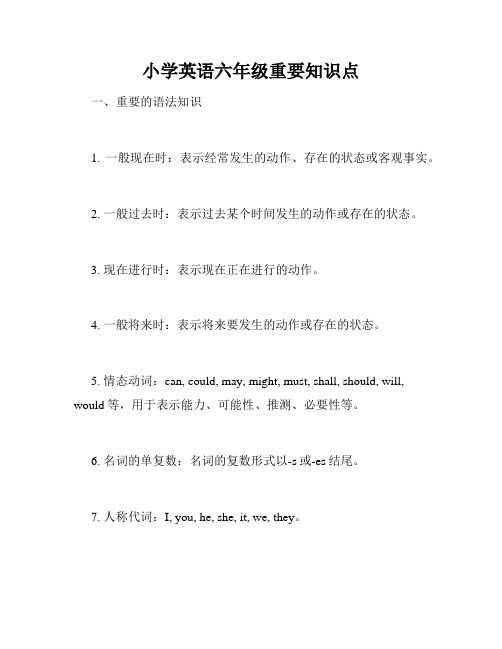
小学英语六年级重要知识点一、重要的语法知识1. 一般现在时:表示经常发生的动作、存在的状态或客观事实。
2. 一般过去时:表示过去某个时间发生的动作或存在的状态。
3. 现在进行时:表示现在正在进行的动作。
4. 一般将来时:表示将来要发生的动作或存在的状态。
5. 情态动词:can, could, may, might, must, shall, should, will, would等,用于表示能力、可能性、推测、必要性等。
6. 名词的单复数:名词的复数形式以-s或-es结尾。
7. 人称代词:I, you, he, she, it, we, they。
8. 形容词的比较级和最高级:通过在形容词前加-er和-est或者在前面加more和most来构成。
9. 反义词/近义词:表示相反意义或接近的词语。
二、重要的词汇和短语1. 数字:千、百、十等数字的读法及运算。
2. 季节和月份:spring, summer, autumn, winter;January, February, March, April, May, June, July, August, September, October, November, December。
3. 食物和饮料:apple, banana, milk, bread, rice, water等。
4. 动物:dog, cat, bird, fish, elephant, tiger, lion, giraffe等。
5. 家庭成员:father, mother, brother, sister, grandparents等。
6. 学科和学校设施:Chinese, English, math, science, school, library, classroom等。
三、重要的句型和对话1. 日常问候用语:如"How are you?" "What's your name?"等。
六年级英语必背知识点归纳
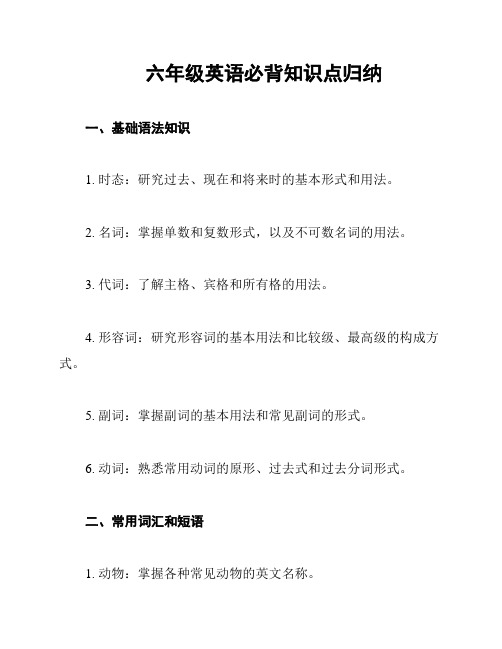
六年级英语必背知识点归纳一、基础语法知识1. 时态:研究过去、现在和将来时的基本形式和用法。
2. 名词:掌握单数和复数形式,以及不可数名词的用法。
3. 代词:了解主格、宾格和所有格的用法。
4. 形容词:研究形容词的基本用法和比较级、最高级的构成方式。
5. 副词:掌握副词的基本用法和常见副词的形式。
6. 动词:熟悉常用动词的原形、过去式和过去分词形式。
二、常用词汇和短语1. 动物:掌握各种常见动物的英文名称。
2. 食物:熟悉各种常见食物的英文名称。
3. 学校:了解学校里的各种地点和设施的英文表达。
4. 家庭:掌握家庭成员的英文称呼和家庭常用词汇。
5. 交通工具:熟悉常见交通工具的英文名称。
三、日常用语和常见句型1. 问候与介绍:掌握日常问候和自我介绍的常用表达。
2. 时间和日期:学会表达时间和日期的基本句型。
3. 祝福与道别:了解常见的祝福和道别用语。
4. 请求和应答:掌握常用的请求和应答句型。
5. 询问和回答:学会询问问题和回答问题的常用句型。
四、阅读理解1. 短文理解:通过阅读短文,理解其中的主要内容和细节。
2. 选择题理解:学会根据问题选择正确的答案。
3. 完形填空:通过选择正确的词语,填充短文中的空白部分。
4. 阅读技巧:掌握一些阅读理解的技巧和方法。
五、口语表达和听力理解1. 日常对话:通过模仿和练,掌握日常对话中的基本表达方式。
2. 听力训练:通过听力练,提高对英语的听力理解能力。
3. 总结归纳:将所学的知识点进行总结归纳,加深记忆。
以上是六年级英语必背知识点的主要内容归纳,希望能对你的研究有所帮助。
英语知识点归纳小学六年级

英语知识点归纳小学六年级一、动词时态1. 一般现在时:表示经常性或习惯性的动作,也可以表示客观真理。
2. 现在进行时:表示现阶段正在进行的动作。
3. 一般过去时:表示过去某个时间发生的动作或状态。
4. 过去进行时:表示过去某个时间正在进行的动作。
5. 一般将来时:表示将来某个时间会发生的动作。
6. 过去将来时:表示过去某个时间会发生的动作,通常用于叙述过去对未来的预测或计划。
二、名词形式1. 可数名词:表示可以数的事物,有单数和复数形式。
2. 不可数名词:表示无法具体数的事物,只有单数形式。
3. 可数名词的复数形式:根据规则变化,如在词尾加-s或-es。
4. 不可数名词的量化:使用量词或不定代词来表示数量。
三、形容词和副词1. 形容词:用于描述名词的特征或性质。
2. 副词:用于描述动词、形容词或副词的程度、方式、时间等。
四、介词的使用1. 方位介词:表示位置、方向等关系,如in、on、under等。
2. 时间介词:表示时间关系,如in、on、at等。
3. 方式介词:表示通过什么方式进行,如by、with等。
五、代词1. 主格代词:用于做主语的代词,如I、you、he等。
2. 宾格代词:用于做宾语的代词,如me、you、him等。
3. 物主代词:表示所有关系的代词,如my、your、his等。
六、连词和从句1. 并列连词:用于连接平行的词、短语或句子,如and、but等。
2. 时间连词:用于连接时间状语从句,如when、while等。
3. 条件连词:用于连接条件状语从句,如if、unless等。
七、比较级和最高级1. 比较级:用于表示两个事物之间的比较,一般在形容词或副词前加-er。
2. 最高级:用于表示三个或三个以上事物之间的比较,一般在形容词或副词前加-est。
八、疑问句和回答1. 一般疑问句:用于询问事实或情况,句首加助动词或be动词。
2. 特殊疑问句:用于询问具体信息,疑问词+一般疑问句结构。
六年级英语知识点归纳整理

六年级英语知识点归纳整理一、单词。
1. 形容词。
- big(大的)、small(小的)、tall(高的)、short(矮的;短的)、long (长的)、fat(胖的)、thin(瘦的)等描述事物特征的形容词。
例如:The elephant is big.(大象很大。
)2. 名词。
- 动物类:cat(猫)、dog(狗)、panda(熊猫)、monkey(猴子)、elephant (大象)、tiger(老虎)等。
如:I like pandas.(我喜欢熊猫。
)- 食物类:apple(苹果)、banana(香蕉)、cake(蛋糕)、bread(面包)、rice(米饭)等。
例如:An apple a day keeps the doctor away.(一天一苹果,医生远离我。
)- 家庭成员类:father(父亲)、mother(母亲)、brother(兄弟)、sister (姐妹)、grandfather(祖父;外祖父)、grandmother(祖母;外祖母)等。
如:My mother is a teacher.(我的妈妈是一名教师。
)3. 动词。
- be动词:am、is、are。
I am a student.(我是一名学生。
)He is my friend.(他是我的朋友。
)They are at school.(他们在学校。
)- 实义动词:like(喜欢)、play(玩)、eat(吃)、drink(喝)等。
例如:I like to play football.(我喜欢踢足球。
)She eats an apple every day.(她每天吃一个苹果。
)二、句型。
1. 主系表结构。
- 肯定句:主语+be动词(am/is/are)+表语。
如:This is my book.(这是我的书。
)- 否定句:主语+be动词(am/is/are)+not+表语。
例如:He is not my brother.(他不是我的兄弟。
六年级英语知识点归纳总结

六年级英语知识点归纳总结今天小编要给大家分享的是六年级英语知识点归纳总结,希望能帮助到大家,快快学习起来吧,打牢基础知识!六年级英语知识点归纳总结Unit 1 How tall are you?一、必背词汇tall ------ taller 高的----更高的 dinosaur 恐龙short ------ shorter 矮的/短的----更矮的/更短的 hall 大厅long ------ longer 长的----更长的 than 比strong------ stronger 强壮的----更强壮的 both 两个都old ------ older 老的/旧的----更老的/更旧的 meter 米形容词 young------ younger 年轻的----更年轻的 kilogram千克;公斤adj. small------ small 小的----更小的 others size 号码thin ------ thinner 瘦的----更瘦的 feet 脚heavy------heavier 重点----更重的 wear 穿low------ lower 低地----更低地 countryside乡村smart------smarter 聪明的 ----更聪明的 shadow 影子;阴影become变成;开始变得辅+元+辅 --------双写最后一个辅音字母+er 辅音字母+y -----改y为i +erbig-----bigger 大的-----更大的 happy-----happier 开心的-----更开心的thin-----thinner 瘦的-----更瘦的 heavy-----heavier 重的------更重的fat-----fatter 胖的------更胖的funny-----funnier 滑稽的------更滑稽的二、重点句型⑴ 问年龄,身高,体重等How old are you? How tall are you? How heavy are you?---- I’m _______ (years old). ---- I’m ______metres tall. ---- I’m ______ kilograms .⑵ 问物品的情况:① How large is your room? 你的房间有多大?It’s __________ m2 (square meters.) 有_______ 平方米。
小学六年级英语知识点归纳(最新)
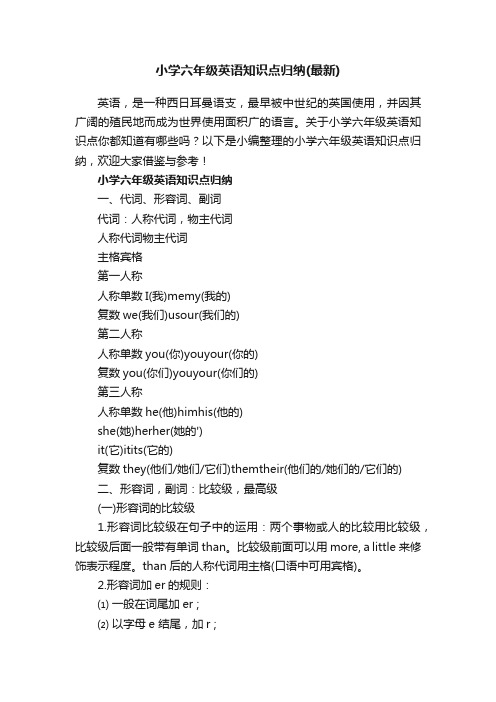
小学六年级英语知识点归纳(最新)英语,是一种西日耳曼语支,最早被中世纪的英国使用,并因其广阔的殖民地而成为世界使用面积广的语言。
关于小学六年级英语知识点你都知道有哪些吗?以下是小编整理的小学六年级英语知识点归纳,欢迎大家借鉴与参考!小学六年级英语知识点归纳一、代词、形容词、副词代词:人称代词,物主代词人称代词物主代词主格宾格第一人称人称单数I(我)memy(我的)复数we(我们)usour(我们的)第二人称人称单数you(你)youyour(你的)复数you(你们)youyour(你们的)第三人称人称单数he(他)himhis(他的)she(她)herher(她的')it(它)itits(它的)复数they(他们/她们/它们)themtheir(他们的/她们的/它们的)二、形容词,副词:比较级,最高级(一)形容词的比较级1.形容词比较级在句子中的运用:两个事物或人的比较用比较级,比较级后面一般带有单词than。
比较级前面可以用more, a little来修饰表示程度。
than后的人称代词用主格(口语中可用宾格)。
2.形容词加er的规则:⑴ 一般在词尾加er ;⑵ 以字母e 结尾,加r ;⑶ 以一个元音字母和一个辅音字母结尾,应双写末尾的辅音字母,再加er ;⑷ 以“辅音字母+y”结尾,先把y变i,再加er 。
3.不规则形容词比较级:good-better, beautiful-more beautiful(二)副词的比较级1.形容词与副词的区别(有be用形,有形用be;有动用副,有副用动)⑴在句子中形容词一般处于名词之前或be动词之后⑵副词在句子中最常见的是处于实义动词之后2.副词比较级的变化规则基本与形容词比较级相同(不规则变化:well-better, far-farther)小学六年级英语要怎么学1.放下心里包袱和压力。
想要将英语学好心态很重要,不要将这门功课想的太难,增加自己的心里负担,有压力就会对这门功课产生一种厌学或者恐惧的心里,对学习有很大的影响,所以一定要学会克服自己的心里,放下包袱。
小学六年级英语知识点积累通用10篇
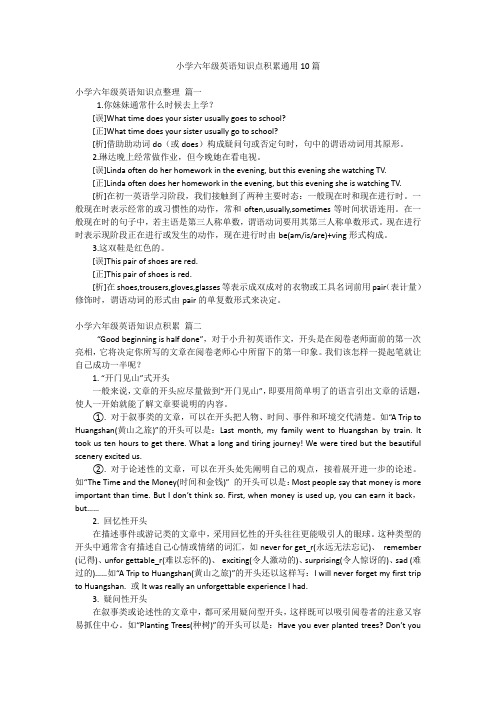
小学六年级英语知识点积累通用10篇小学六年级英语知识点整理篇一1.你妹妹通常什么时候去上学?[误]What time does your sister usually goes to school?[正]What time does your sister usually go to school?[析]借助助动词do(或does)构成疑问句或否定句时,句中的谓语动词用其原形。
2.琳达晚上经常做作业,但今晚她在看电视。
[误]Linda often do her homework in the evening, but this evening she watching TV.[正]Linda often does her homework in the evening, but this evening she is watching TV.[析]在初一英语学习阶段,我们接触到了两种主要时态:一般现在时和现在进行时。
一般现在时表示经常的或习惯性的动作,常和often,usually,sometimes等时间状语连用。
在一般现在时的句子中,若主语是第三人称单数,谓语动词要用其第三人称单数形式。
现在进行时表示现阶段正在进行或发生的动作,现在进行时由be(am/is/are)+ving形式构成。
3.这双鞋是红色的。
[误]This pair of shoes are red.[正]This pair of shoes is red.[析]在shoes,trousers,gloves,glasses等表示成双成对的衣物或工具名词前用pair(表计量)修饰时,谓语动词的形式由pair的单复数形式来决定。
小学六年级英语知识点积累篇二“Good beginning is half done”,对于小升初英语作文,开头是在阅卷老师面前的第一次亮相,它将决定你所写的文章在阅卷老师心中所留下的第一印象。
我们该怎样一提起笔就让自己成功一半呢?1. “开门见山”式开头一般来说,文章的开头应尽量做到“开门见山”,即要用简单明了的语言引出文章的话题,使人一开始就能了解文章要说明的内容。
六年级英语知识点归纳大全

六年级英语知识点归纳大全
以下是六年级英语知识点的归纳大全:
1. 词汇与拼写:
- 词汇扩充:学习新的词汇,如动词、名词、形容词等,并学会正确拼写。
- 同义词和反义词:学习一些常见的同义词和反义词,以扩展词汇量和丰富表达方式。
2. 语法与句型:
- 时态:学习过去时、现在时和将来时,了解其用法和构成规则等。
- 名词与代词:学习名词的单复数形式和代词的主格、宾格等基本用法。
- 动词的时态与语态:了解动词的各种时态和语态,如一般现在时、进行时、被动语态等。
3. 句子结构:
- 主谓一致:学习主语和谓语动词在人称和数上的一致关系。
- 从句:学习宾语从句和定语从句的基本用法和引导词。
4. 阅读理解:
- 阅读短文:学习阅读短文并理解其中的信息,回答问题和推断作者意图。
5. 听力与口语:
- 听力训练:通过听录音,提升听懂英语口语对话和简短句子的能力。
- 口语表达:通过口语练习,提高发音准确性和口语表达的流利度。
6. 写作与交流:
- 书面表达:学习如何写简单的文章和邮件,培养书写和表达能力。
- 交际对话:学习如何进行日常交流和情景对话,如问候、介绍、道歉等。
7. 文化与习俗:
- 跨文化交流:了解不同国家和地区的文化和习俗,培养对多样性的尊重和欣赏意识。
以上是六年级英语课程的核心知识点。
通过掌握这些知识,学生可以提高英语词汇量、语法运用能力,加强听说读写的综合能力,同时了解不同文化和语言的背景。
请注意,具体教材和教学要求可能有所不同,建议参考学校教材和教师的指导,全面学习和巩固这些知识点。
六年级英语知识点归纳和整理

六年级英语知识点归纳和整理一、基础知识词汇:六年级的词汇量较之前有所增加,涉及更多日常生活和学习相关的词汇。
例如,学科类的词汇(math, science, English等)、食物和饮料(hamburger, pizza, orange juice等)、家庭成员(uncle, aunt, cousin等)。
语法:六年级的语法知识主要包括一般现在时、现在进行时、一般过去时等基础时态。
此外,还包括形容词、副词的比较级和最高级,以及简单的定语从句和宾语从句。
二、重点知识时态:一般现在时:描述经常发生的动作或状态,如“I usually go to school at 7:30.”。
现在进行时:描述正在进行的动作,如“She is reading a book now.”。
一般过去时:描述过去发生的动作或状态,如“Yesterday, I went to the park with my friends.”。
形容词和副词:形容词用于描述名词的状态或特征,如“big house”中的“big”。
副词用于描述动词的方式或程度,如“run fast”中的“fast”。
比较级和最高级:比较级用于比较两个事物,如“He is taller than me.”。
最高级用于比较三个或更多的事物,如“She is the tallest girl in our class.”。
三、常见句型和表达日常用语:如“Thank you.”, “You're welcome.”, “Sorry, I'm late.”等。
简单句型:如陈述句(I am a student.)、疑问句(Are you happy?)、否定句(I don't like apples.)等。
简单对话:能够进行简单的日常对话,如询问和回答个人信息、描述事物等。
四、学习方法多听多说:通过听录音、看英语电影、与外国人交流等方式,提高听力和口语能力。
- 1、下载文档前请自行甄别文档内容的完整性,平台不提供额外的编辑、内容补充、找答案等附加服务。
- 2、"仅部分预览"的文档,不可在线预览部分如存在完整性等问题,可反馈申请退款(可完整预览的文档不适用该条件!)。
- 3、如文档侵犯您的权益,请联系客服反馈,我们会尽快为您处理(人工客服工作时间:9:00-18:30)。
Are there any students in the classroom?
Yes, there are. / No,there aren’t.
常见题型:
1. Amy likes playing computer games.(改为一般疑问句 并作否定回答)
you doing?
(三)一般将来时
1.概念:表示将要发生的动作或存在的状态及打算、 计划或准备做某事。句中一般有以下时间状语: tomorrow, next day(week, month, year…),soon, the day after tomorrow后天等
play_____run______swim ____make__________ go_________ like________ write________ read________ have_________ sing ____ dance_________ put_________love____________ live_______ take_________ come ________ get_________stop_________ sit ________ begin_______shop___________
policewoman-policewomen, child-children, foot-feet, tooth-teeth ,fish-fish, people-people, sheep-sheep
写出下列各词的复数: tomato___candy____this __month__ watch __child __photo __diary ______ day____ foot____book__dress ______ tooth__sheep __box__ strawberry ____ leaf ____peach__ sandwich __ man____woman____juice___bus__
词汇
学生易错词汇:
1. a, an的选择: 用于以元音音素(音标)开头的单词前用an,用于 以辅音音素(音标)开头的单词前用α.
例子:This is a teacher. This is an apple. She is a
university student. 2. am , is , are的选择: 单数用is , 复数用are. I 用 am , you 用
5.She is going to listen to music after school.(改为否定 句)
九、时态归类
( 一)一般现在时 一般现在时基本用法介绍 1.表示事物或人物的特征、状态。如:The sky is blue.天空是蓝色的。 2.表示经常性或习惯性的动作。如:I get up at six every day.我每天六点起 床 一般现在时的时间状语有:often, usually, sometimes,always等。 一般现在时的构成 1. be动词:主语+be(am,is,αre)+其它。如: I am a boy.我是一个男孩。 2.动词:主语+动词(+其它)。如:We study English.我们学习英语。 当主语为第三人称单数(he, she,it)时,动词用第三人称单数形式 。如: Mary likes Chinese.玛丽喜欢汉语。
(3)没有动词be和can的句子则要先在主要动 词的前面加上一个助动词(do,does,did),然 后在它后面加上“not”,要注要的是否定句后面 接的动词都要用原形。你也可以把它们缩写在一 起如(“don’t , doesn’t , didn’t) 。这三个 助动词要根据人称和时态来选择,其中“does” 只用于一般现在时主语是第三人称单数的情况, 而“did”只用于一般过去时,不论主语是什么人 称和数,都用“did” 。
stopped plan--planned
2.不规则动词(此类词并无规则,须熟记)小学阶段要记住以下动词的原形和过去式 :sing – sang , eat – ate , see – saw , have – had , do – did , go – went , take – took , buy – bought , get – got , read – read ,fly – flew , am/is – was , are – were , say – said , make – made , swim – swam , tell – told , come – came , thinkthought, drink – drank , hurt – hurt , feel – felt , put – put , fall-fell.
如:I like apples. Do you like apples? Yes, I do. /No, I don’t.
She likes apples. Does she like apples? Yes, she does. /No, she doesn’t.
She went fishing yesterday. Did she went fishing yesterday? Yes, she did. /No, she didn’t.
六、 动词加ing的变化规则
1.一般情况下,直接加ing,如:cook-cooking 2.以不发音的e结尾,去e加ing,如:like-liking; writewriting;make-making;take-taking 3.以重读闭音节结尾并且末尾只有一个辅音字母的要双写未尾 的辅音字母再加ing,如:get-getting; run-running, swimswimming,shop-shopping stop-stopping,sit-sitting,put-putting 写出下列动词的现在分词:She ca sweep the floor.
Can she sweep the floor? Yes,she can.No,she cann’t.
②没有动词be/can的句子则要在句首加上一个助动词 (do,does,did)再把紧跟在后面的动词变回原 形,末尾标点符号变成问号即可。这三个助动词也 要根据人称和时态来选择,其中“does”只用于一 般现在时主语是第三人称单数的情况,而“did” 只用于一般过去时,不论主语是什么人称和数,都 用“did” 。当句子用“does”和 “did”来提问 时,后面的动词要用原形。
八、句型专项归类
1.肯定句变否定句:肯定句:指用肯定的语气来陈述的 句子。否定句:含有否定词或表示否定意义词的句子。
否定句主要是在肯定句的基础上加上了否定词 “not”。 (1)有动词be的句子则在be后面加“not”,可缩写 成“isn’t,aren’t”,但am not 一般都分开写。 (2)没有动词be ,有can的,在can后面加“not”,完 整形式can not,可缩写成can’t.
drink _____go ____stay ___make ________ look _____have___pass_____carry ____
come____watch__plant_____ fly ________ study_____ brush____ do____ teach_______
动词的过去式的构成规则
1.规则动词 ① 一般直接在动词的后面加ed:如 work -- worked ,
learn -- learned , clean-- cleaned , visit -- visited ②以e结尾的动词直接加d:如 live -- lived , dance --
danced , use – used , prepare - prepared ③ 以辅音字母加y结尾的动词要改y为i再加ed(此类动 词较少)如 study – studied ,carry – carried ,worry – worried (注意play、stay不是辅音字母加y,所以不属于 此类) ④ 双写最后一个字母(此类动词较少)如 stop --
2. They are doing housework .(分别改成一般疑问句和否 定句)
3.The students are cleaning the classroom . ( 改为否定 句)
4. They went to a park yesterday.( 改一般疑问句并作肯 定和否定回答)
③第一人称要改为第二人称,如:I改为you, my改为your. I am a student. Are you a student? Yes, Iam / No, I’m not.
一般疑问句有个重要的原则就是问和答要一致 ,即问句里的第一个单词(助动词)和简略 答句里的这个词是一致的。
④当句子中出现some时,改为一般疑问句时 ,要改为any。
( 二)现在进行时
1.现在进行时表示现在正在进行或发生的动作也 可表示当前一段时间内的活动或现阶段正在进 行的动作。通常带有now, listen, look等时间 词。
2.现在进行时的肯定句基本结构为be+动词ing. 3.现在进行时的否定句在be后加not。 4.现在进行时的一般疑问句把be动词调到句首。 5.现在进行时的特殊疑问的基本结构为: 疑问词+ be + 主语 + 动词ing? 如:What are
五、动词第三人称单数规则
1.一般情况下,直接加-s,如:cook-cooks, like-likes 2.以s. x. sh. ch. o结尾,加-es,如:go-goes,dodoes teach-teaches, wash-washes, watch-watches, 3.以“辅音字母+y”结尾,变y为i, 再加-es,如: study-studies, fly-flies 4.不规则变化:have-has 写出下列动词的第三人称单数
